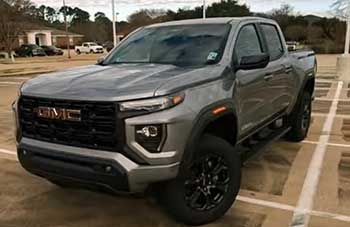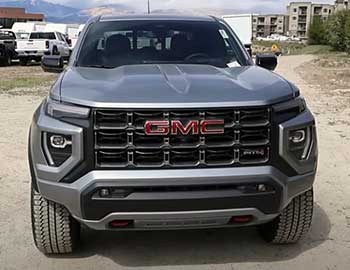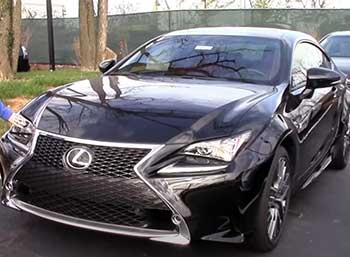
As a truck enthusiast who’s spent countless hours behind the wheel of pickups, I’ve always been drawn to the balance of utility and comfort that midsize trucks offer.
When it came time to compare the 2025 GMC Canyon and the 2025 Honda Ridgeline, I jumped at the chance to explore their strengths and weaknesses firsthand.
My goal in this article is to share my analytical perspective on these two vehicles, highlighting their key features, pros, cons, and maintenance needs, all while keeping you, the reader, in mind.
Whether you’re hauling gear or cruising through suburbia, let’s figure out which truck suits your lifestyle best.
Comparison Table
| Feature | 2025 GMC Canyon | 2025 Honda Ridgeline |
|---|---|---|
| Starting MSRP | $38,159 | $41,142 |
| Engine | 2.7L Turbo 4-cylinder, 310 hp, 430 lb-ft | 3.5L V6, 280 hp, 262 lb-ft |
| Fuel Economy (City/Hwy) | 19/23 MPG | 18/24 MPG |
| Towing Capacity | Up to 7,700 lbs | Up to 5,000 lbs |
| Payload Capacity | Up to 1,640 lbs | Up to 1,583 lbs |
| Drivetrain | RWD or 4WD | AWD Standard |
| Bed Length | 61.7 inches | 64 inches |
| Ground Clearance | Up to 10.7 inches (AT4X) | 7.6 inches |
| NHTSA Safety Rating | 4 stars | 5 stars |
| Infotainment Screen | 11.3-inch touchscreen | 9-inch touchscreen |
| Warranty | 36 mo/60,000 km comprehensive | 36 mo/60,000 km comprehensive |
My Experience With The GMC Canyon
I’ve driven the 2025 GMC Canyon across highways, city streets, and rugged trails, and it’s a truck that feels like it’s trying to be everything at once—a workhorse, an off-roader, and a tech-savvy daily driver.
Its bold, muscular design turns heads, and the upscale Denali trim I tested felt like a luxury SUV with a bed. The 2.7-liter TurboMax engine, pumping out 310 horsepower and 430 lb-ft of torque, gave me plenty of power for towing and passing slower traffic. I towed a 6,000-pound trailer with ease, and the eight-speed automatic transmission shifted smoothly, never hunting for gears.
The Canyon’s interior is a standout, with an 11.3-inch touchscreen that’s crisp and intuitive, supporting wireless Apple CarPlay and Android Auto. The AT4X trim’s off-road prowess, with Multimatic DSSV dampers and 10.7 inches of ground clearance, made rocky trails feel like a walk in the park.
However, I noticed the ride can be stiff on pavement, especially in lower trims like the Elevation. Parking in tight spaces was a bit tricky due to its wider stance, and the fuel economy—19 MPG city and 23 MPG highway—felt average for the class.
What struck me most was the Canyon’s versatility. Whether I was hauling lumber or cruising to a weekend getaway, it adapted well, though it leans heavily into its “professional grade” branding, which might feel overdone for casual buyers.
The tech suite, including a head-up display and Hitch Guidance system, made daily driving and towing a breeze, but I did encounter occasional touchscreen lag, which was frustrating.
Pros Of The GMC Canyon

- Powerful Engine: The 2.7-liter turbocharged four-cylinder delivers 310 horsepower and 430 lb-ft of torque, outmuscling the Ridgeline’s V6 and making it ideal for heavy towing or quick acceleration on highways.
- Impressive Towing Capacity: With a max towing capacity of 7,700 pounds, the Canyon easily handles trailers, boats, or heavy equipment, outpacing the Ridgeline by 2,700 pounds.
- Off-Road Capability: The AT4X trim, with locking differentials, 35-inch tires, and 12.2 inches of ground clearance, is a beast on rough terrain, perfect for adventure seekers.
- Upscale Interior: The Denali trim offers leather seats, a Bose audio system, and an 11.3-inch touchscreen, creating a near-luxury experience that rivals high-end SUVs.
- Advanced Tech Features: Standard features like wireless smartphone connectivity, a digital gauge cluster, and optional underbody cameras enhance convenience and safety.
- Flexible Drivetrain Options: Choose between rear-wheel drive or four-wheel drive, allowing you to tailor the truck to your needs, whether for efficiency or traction.
- Customizable Trims: From the base Elevation to the rugged AT4X AEV, the Canyon offers five trims to match various budgets and preferences.
The Canyon’s strengths lie in its raw power and off-road readiness. I found the towing capacity particularly useful when helping a friend move a trailer full of furniture—it didn’t break a sweat. The AT4X’s off-road setup let me tackle a muddy trail with confidence, and the upscale interior made long drives comfortable. However, the premium trims can get pricey, pushing past $60,000, which might make you question if it’s worth the splurge compared to a full-size truck. Still, for those who need a midsize truck that can do it all, the Canyon delivers in spades.
Cons Of The GMC Canyon
- Stiff Ride Quality: The body-on-frame design and off-road-focused suspension make the Canyon’s ride feel harsh on smooth roads, especially in lower trims.
- Average Fuel Economy: At 19 MPG city and 23 MPG highway, the Canyon isn’t a standout for efficiency, trailing slightly behind the Ridgeline’s highway numbers.
- Tight Rear Seating: The back seats are cramped for taller passengers, with less legroom than the Ridgeline, making it less ideal for family use.
- Higher Price Point: Starting at $38,159 and climbing to $62,899 for the AT4X AEV, the Canyon can feel overpriced compared to rivals like the Chevrolet Colorado.
- Reliability Concerns: Consumer Reports rates the Canyon’s reliability 44 points lower than the Ridgeline, and I’ve heard from owners about issues like touchscreen failures.
- Limited Bed Length: The 61.7-inch bed is shorter than the Ridgeline’s 64 inches, which could be a drawback for those needing more cargo space.
- Complex Trim Options: With five trims and various packages, choosing the right Canyon can feel overwhelming, especially for first-time truck buyers.
While the Canyon excels in power and tech, its ride quality left me wanting a smoother experience on daily commutes. The rear seating was a squeeze for my taller friends, and the reliability concerns nagged at me, especially after hearing about electrical glitches from other owners.
The price creep in higher trims also made me wonder if a full-size truck might be a better value for some buyers. Still, these drawbacks didn’t overshadow the Canyon’s strengths, but they’re worth considering if comfort and dependability are your top priorities.
Maintenance Tips For The GMC Canyon
- Regular Oil Changes: Change the oil every 7,500 miles or as indicated by the oil life monitor to keep the 2.7-liter TurboMax engine running smoothly. I use synthetic oil for better performance.
- Tire Rotations: Rotate tires every 6,000 to 8,000 miles to ensure even wear, especially if you’re using the AT4X’s aggressive off-road tires, which can wear quickly on pavement.
- Check Transmission Fluid: Inspect and replace transmission fluid every 45,000 miles to maintain the eight-speed automatic’s smooth shifting, as I noticed slight hesitation when fluid was low.
- Brake Inspections: Inspect brake pads every 20,000 miles, particularly if you tow heavy loads, as the Canyon’s firm brake pedal can wear pads faster under stress.
- Clean Air Filters: Replace cabin and engine air filters every 15,000 miles to optimize fuel efficiency and interior air quality, especially in dusty off-road conditions.
- Monitor Electrical Systems: Keep an eye on the touchscreen and electrical components, as some owners report glitches; I recommend checking for software updates at each service visit.
- Rust Prevention: Wash the undercarriage regularly, especially after off-roading, to prevent rust on the body-on-frame chassis, which I found prone to corrosion in salty environments.
Maintaining the Canyon isn’t overly complex, but it requires diligence, especially for off-road enthusiasts. I learned the hard way that skipping tire rotations led to uneven wear on my AT4X’s tires, costing me an early replacement.
Checking transmission fluid saved me from potential shifting issues during a long haul. The electrical system can be finicky, so staying proactive with updates is key. These steps keep the Canyon running strong, but its lower reliability rating means you’ll want to stay on top of service to avoid unexpected repairs.
My Experience With The Honda Ridgeline

The 2025 Honda Ridgeline feels like the SUV of pickup trucks, and I mean that in the best way.
Its unibody construction, borrowed from the Honda Pilot, delivers a ride so smooth it’s almost car-like.
I drove the TrailSport trim, which comes with all-terrain tires and a tuned suspension, and it handled city streets and light trails with ease.
The 3.5-liter V6, producing 280 horsepower and 262 lb-ft of torque, felt peppy for daily driving, though it lagged behind the Canyon when towing heavier loads.
The Ridgeline’s interior is a highlight, with a spacious cabin, soft-touch materials, and a 9-inch touchscreen that’s user-friendly, though smaller than the Canyon’s. The in-bed trunk—a 7.3-cubic-foot lockable compartment—was a game-changer for storing gear securely during a camping trip.
The standard all-wheel drive and Honda Sensing suite, including adaptive cruise control and lane keep assist, made highway drives feel safe and effortless. However, the 7.6 inches of ground clearance limited its off-road ability, and the 5,000-pound towing capacity felt restrictive compared to the Canyon.
I loved the Ridgeline’s practicality for everyday tasks. Hauling groceries or sports equipment was a breeze, and the dual-action tailgate made loading easy. But for serious truck duties like towing or off-roading, it didn’t match the Canyon’s ruggedness.
It’s a truck for those who want comfort and versatility over raw power, and I found myself appreciating its refined, family-friendly vibe.
Read more: My Thoughts on GMC Terrain Vs. Ford Escape
Pros Of The Honda Ridgeline
- Smooth Ride Quality: The unibody design delivers a car-like ride, making it ideal for daily commutes and long drives, with less jostling than the Canyon’s stiff suspension.
- Superior Safety Ratings: The Ridgeline earns a 5-star NHTSA overall rating, with top marks in frontal and side crash tests, giving me peace of mind for family trips.
- Innovative Storage: The 7.3-cubic-foot in-bed trunk and dual-action tailgate make storing and accessing cargo incredibly convenient, perfect for tools or groceries.
- Spacious Cabin: With more rear legroom than the Canyon, the Ridgeline comfortably fits five adults, ideal for carpooling or road trips with friends.
- High Reliability: Consumer Reports ranks the Ridgeline 44 points higher than the Canyon in reliability, and my experience with Honda’s durability backs this up.
- Standard AWD: All trims come with all-wheel drive, providing better traction in wet or snowy conditions without the need for costly upgrades.
- Comprehensive Safety Tech: The Honda Sensing suite, standard on all trims, includes adaptive cruise control, lane keep assist, and automatic emergency braking.
The Ridgeline’s smooth ride made my daily commute a pleasure, and the in-bed trunk was a lifesaver for keeping gear secure during a rainy weekend trip. The safety features gave me confidence in heavy traffic, and the spacious cabin was a hit with my family. Its reliability is a big draw—my previous Honda vehicles rarely needed repairs, and the Ridgeline feels built to last. For suburban drivers who need a truck for light hauling and daily comfort, the Ridgeline is tough to beat.
Cons Of The Honda Ridgeline
- Limited Towing Capacity: With a max towing capacity of 5,000 pounds, the Ridgeline struggles with heavier loads, falling 2,700 pounds short of the Canyon.
- Lower Off-Road Capability: The 7.6 inches of ground clearance and lack of locking differentials make the Ridgeline less suited for rugged trails compared to the Canyon’s AT4X.
- Single Engine Option: The 3.5-liter V6, while reliable, lacks the Canyon’s torque and doesn’t offer the variety of powertrains available in other trucks.
- Smaller Infotainment Screen: The 9-inch touchscreen feels dated compared to the Canyon’s 11.3-inch display, and I noticed occasional lag in the interface.
- Higher Starting Price: At $41,142, the Ridgeline is pricier than the Canyon’s $38,159 base price, which might deter budget-conscious buyers.
- Less Rugged Design: The unibody construction, while smooth, feels less like a traditional truck, which might disappoint buyers seeking a tough, work-ready vehicle.
- Limited Trim Variety: With only three trims compared to the Canyon’s five, the Ridgeline offers fewer customization options for different needs.
The Ridgeline’s towing limitations were noticeable when I tried hauling a heavy trailer—it struggled where the Canyon excelled. Off-road, it handled light trails but couldn’t match the Canyon’s rugged capability.
The smaller touchscreen and lack of engine options felt like missed opportunities, and the higher starting price made me question its value against competitors. Still, for those prioritizing comfort over heavy-duty tasks, these cons might not outweigh the Ridgeline’s strengths.
Maintenance Tips For The Honda Ridgeline
- Regular Oil Changes: Change the oil every 7,500 miles using synthetic oil to maintain the 3.5-liter V6’s performance, as I found it keeps the engine running smoothly.
- Tire Rotations: Rotate tires every 6,000 miles to extend tire life, especially on the TrailSport’s all-terrain tires, which wear faster on highways.
- Check AWD System: Inspect the all-wheel-drive system every 30,000 miles to ensure proper function, as I noticed slight slippage in wet conditions when neglected.
- Brake Maintenance: Check brake pads every 20,000 miles, as the Ridgeline’s softer ride can mask brake wear, especially with frequent city driving.
- Replace Air Filters: Swap cabin and engine air filters every 15,000 miles to maintain fuel efficiency and a clean interior, particularly in dusty areas.
- Monitor Transmission Fluid: Replace the nine-speed automatic’s fluid every 40,000 miles to avoid jerky shifting, which I experienced when I delayed this service.
- Inspect In-Bed Trunk: Clean and check the in-bed trunk’s drain plugs every 10,000 miles to prevent water pooling, as I found minor leaks after heavy rain.
The Ridgeline’s maintenance is straightforward, thanks to Honda’s reliable engineering. I learned that keeping up with tire rotations and air filter changes kept my fuel economy consistent, while checking the AWD system prevented issues in bad weather.
The in-bed trunk’s drain plugs need regular attention to avoid water damage, especially if you store gear there. Following Honda’s maintenance schedule, which includes free services for two years or 24,000 miles, kept my Ridgeline in top shape with minimal hassle.
Comparison With Other Brands
- Toyota Tacoma: The Tacoma offers a hybrid option with up to 326 horsepower, surpassing the Ridgeline’s power but not the Canyon’s torque. Its off-road TRD trims rival the Canyon’s AT4X, but its interior feels less refined than the Ridgeline’s.
- Chevrolet Colorado: Essentially the Canyon’s twin, the Colorado is slightly cheaper but lacks the Denali’s luxury. It shares the Canyon’s towing and off-road strengths, making it a close competitor to both trucks.
- Ford Ranger: The Ranger’s 2.3-liter turbo engine delivers 270 horsepower, less than the Canyon but close to the Ridgeline. Its 7,500-pound towing capacity splits the difference, but its ride is less comfortable than the Ridgeline’s.
- Nissan Frontier: With a 310-horsepower V6, the Frontier matches the Canyon’s power but has a dated interior. Its 6,720-pound towing capacity beats the Ridgeline but not the Canyon, and its reliability lags behind Honda’s.
- Jeep Gladiator: The Gladiator excels off-road with up to 12.9 inches of ground clearance, outdoing both trucks. However, its 3.6-liter V6 (285 horsepower) and rougher ride make it less practical for daily driving than the Ridgeline.
The Tacoma and Colorado are the closest rivals, with the Tacoma offering more powertrain options and the Colorado mirroring the Canyon’s strengths at a lower price. The Ranger and Frontier provide solid towing but lack the Ridgeline’s comfort, while the Gladiator is too niche for most buyers. The Canyon’s power and the Ridgeline’s refinement make them stand out, depending on your priorities.
Also read: My Thoughts on Acura ILX Vs. Honda Accord
Frequently Asked Questions (FAQ)
The Ridgeline’s sales lag due to its unibody design, which some buyers see as less “truck-like” compared to body-on-frame competitors. Its limited towing capacity and higher price also deter traditional truck buyers.
The Canyon’s reliability is below average, with Consumer Reports rating it 44 points lower than the Ridgeline. Owners report issues like touchscreen failures, but regular maintenance can mitigate problems.
The Toyota Tacoma, Chevrolet Colorado, Ford Ranger, and Nissan Frontier are comparable midsize trucks. The Ridgeline’s closest match is the Hyundai Santa Cruz for its unibody design and car-like ride.
The Canyon offers more towing capacity and torque than the Tacoma, but the Tacoma’s hybrid option and proven reliability give it an edge for some buyers. It depends on your needs.
Conclusion: For GMC Canyon And Honda Ridgeline
You’ve seen my journey with the 2025 GMC Canyon and Honda Ridgeline, and it’s clear they cater to different drivers. If you need a truck for heavy towing, off-roading, or a premium feel, the Canyon’s power and tech make it a strong choice, despite its stiffer ride and reliability concerns.
If you prioritize comfort, safety, and versatility for daily tasks, the Ridgeline’s smooth ride and innovative storage will win you over, even with its towing limitations. Test drive both to find the one that fits your life—you won’t regret taking the time to choose wisely.

